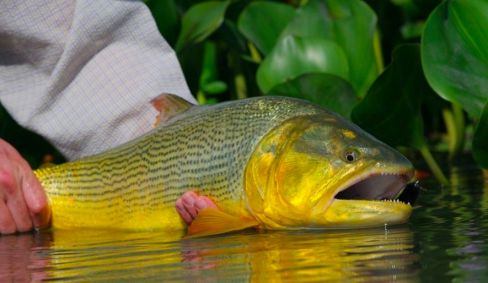It´s late afternoon and every living creature are preparing to face the mysteries of night. The concert of frogs deserves to be recorded. Two storks pass flying over my humanity. I´m submerged waist-deep in muddy water. I’ve arrived to the clearing in the vegetation a few minutes ago and I’m still studying the environment. A hunter's ancestral instinct keeps me alert. As light fades, my ears take command of my actions. An explosion in the middle of the clearing reveals the presence of my rival. The popper falls near the conflict zone and disappears instantly on a more acoustic than visual scene. The rest is a combination of brute force and shrewdness by the wolf fish and proud soul on me.
Wolf fish (Hoplias malabaricus) is one of those species that is close to many fly fishers in Argentina. A species ignored by most and completely misunderstood since very specific techniques are required.
Fishing season may extend from October to May, depending on weather conditions.
Historically, my places were some lagoons in the Salado River Basin, and those of Bragado and its surroundings. In recent times, my home in Capitán Sarmiento became an interesting spot, albeit it was difficult to approach. Another place that I also frequent is the Lechiguanas Delta in Entre Rios.
Minimizing wolf fish fishing to loafing around a popper during a summer day would be a mistake. It is a complex species, with attitudes not yet understood. The fixed believe of the unconscious collective is that they could only be caught with large and noisy poppers. In many occasions during the season they react extraordinarily well to those flies. Popper´s can attract the attention of the fish and make it swim several meters looking forward to pounce on it. It is spectacular, even though there are other ways to fish, landing wolf fish in situations that otherwise would have ended in a total cero. Don’t blame the moon, try new techniques.
In many environments the big ones have fallen in all kinds of traps and became wise. The watchful fisherman would have noticed that something was following the fly without biting it. It is an astute fish with good memory.
Early in the season, after runs of several days with temperatures above 24-25 degrees Celsius, wolf fish move to shallow water, exposing part of their body above the surface. In order to locate them, you must take a look around. The best time it is at noon, when they are sunning static, neither feeding nor spawning; they seek to raise their body temperature without consuming the energy reserve stored as body fat. During those moments you really need to bother them with your fly to get a strike. Design of flies should embrace patterns that sink and swim inverted in order to avoid getting stuck on the bottom. Clouser Minnow patterns are a good starting point, and they don´t have to be too large.
It is important to get as close as possible to the target fish and watch its postural reaction. When it gets angry it starts moving the fins, then slightly arches its body and rises in the water column. Make sure the fish has the fly inside its mouth before pulling with the line hand. Try not to lift the rod. If you try to set the hook using the rod, it will absorb much of the energy, preventing a good hook set.
During the afternoon you can find some fish patrolling. Another common belief is that wolf fish is an ambush hunter. Both in streams and lagoons, during the afternoon, they leave their spots and go slowly swimming around, looking for food.
At the beginning of the season, the best approach to those fish is to use a popper or deer hair slider. A long following may precede the strike. Sometimes it interrupts the attack, going a bit backwards. It is not a rejection of the fly but, as the surface water temperature is not uniform, when they get to colder water, they just avoid it. They get back to warmer water. This doesn’t occur during summer and fall, when the strike is sudden and brutal.
Although sight fishing is extremely effective, a good option is walking along the bank to spook them away in order to detect them. They rarely go away more than a few meters, and within minutes they have a good attitude towards feathers again.
When a big one rejects the fly, it could be teased again by a radical change in fly silhouette. For example, when fishing a rat imitation a fish comes up but rejects it. After eternal minutes without any news, you switch to a streamer. In the first shot a torpedo takes, you try to hold the line when it suddenly it jumps out of the water, it arches again before it lands... pure adrenaline!
The use of streamers is essential to be consistent with the big ones. During the last couple of seasons I have caught less than a quarter of them with surface flies. Streamers imitate fish, the main diet of this species in most environments. Fly size can range from 2 to 5 inches long. My basic selection includes woolly buggers, marabou muddlers, deceivers, clouser minnows and golden dorado streamers.
The last trophy fish took a huge pink and black streamer. As soon as I went close to a small bay I saw several large fish suspended on the surface, moving in a frolic way. I landed one in the first cast with a popper while the rest disappeared. We beat the entire place, creating such a mess that only little ones came closer. I changed to a streamer, let it sink and slowly retrieved using the reel. I don’t think it covered more than half a meter before it was smashed down.
Please practice Catch & Release
Tight lines,
Nicolás Schwint



